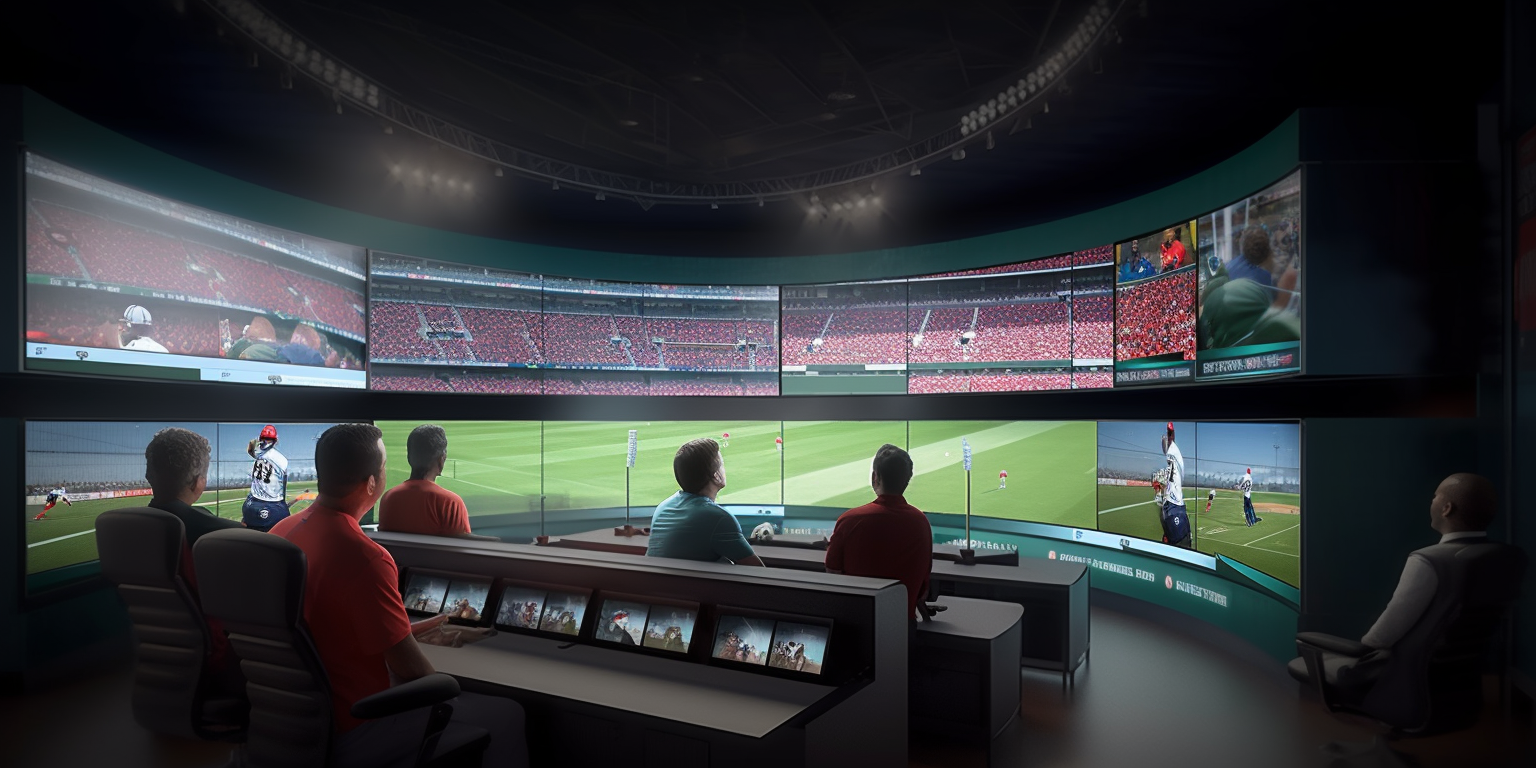Sports broadcasting has come a long way since the days of black and white television sets. Today, fans can watch their favorite sports teams from anywhere in the world, thanks to the internet and advancements in technology. However, the future of sports broadcasting is set to be even more immersive, with virtual reality (VR), augmented reality (AR), and 5G technology leading the way.
Immersive experiences are becoming increasingly popular in the world of sports broadcasting. VR technology allows fans to feel like they are right in the middle of the action, with 360-degree views of the game. AR technology, on the other hand, overlays digital information onto the real world, providing fans with additional information about the game, such as player stats and scores.
5G technology is set to revolutionize sports broadcasting by providing faster and more reliable internet connections. This will allow fans to stream live games in high definition without any lag or buffering. It will also enable broadcasters to provide more immersive experiences, such as VR and AR, without any delays or glitches.
The future of sports broadcasting is not just about providing fans with a better viewing experience. It is also about creating new revenue streams for sports teams and broadcasters. For example, VR technology could be used to sell virtual tickets to games, allowing fans to experience the game from the comfort of their own homes. AR technology could be used to sell merchandise, with fans able to see what a particular item would look like on them before making a purchase.
In conclusion, the future of sports broadcasting is set to be more immersive than ever before. VR, AR, and 5G technology will provide fans with a more engaging and interactive viewing experience, while also creating new revenue streams for sports teams and broadcasters. As technology continues to evolve, the possibilities for sports broadcasting are endless.
Benefits of Immersive Viewing
Sports broadcasting has come a long way since the days of black and white television sets. With the advent of immersive viewing experiences, sports fans can now feel like they are right in the middle of the action. Immersive experiences such as virtual reality (VR) and augmented reality (AR) are changing the way we watch sports, and the future looks bright.
One of the biggest benefits of immersive viewing experiences is the ability to feel like you are actually at the game. With VR, fans can put on a headset and be transported to the stadium, where they can watch the game from any angle they choose. This allows fans to feel like they are right in the middle of the action, and can even give them a better view than they would have if they were actually at the game.
AR, on the other hand, allows fans to overlay digital information on top of the real world. This can be used to display stats, replays, and other information that can enhance the viewing experience. For example, during a football game, AR could be used to display the route that a receiver ran on a particular play, or to show the trajectory of a field goal attempt.
Another benefit of immersive viewing experiences is the ability to watch games in 360 degrees. This allows fans to see the action from every angle, and can even be used to create a personalized viewing experience. For example, a fan could choose to focus on a particular player throughout the game, or could switch between different camera angles to get a better view of the action.
All of these immersive viewing experiences are made possible by advancements in technology, particularly 5G. With 5G, the speed and reliability of wireless networks is greatly improved, which allows for faster and more seamless streaming of VR and AR content. This means that fans can enjoy immersive viewing experiences without any lag or buffering, which can greatly enhance the overall experience.
In conclusion, the future of sports broadcasting looks bright thanks to immersive viewing experiences. With VR, AR, and 5G technology, fans can feel like they are right in the middle of the action, and can enjoy a personalized and enhanced viewing experience. As technology continues to advance, the possibilities for immersive viewing experiences are endless, and sports fans are sure to benefit.
Virtual Reality and Augmented Reality Experiences
Today, fans can enjoy immersive viewing experiences that transport them right into the heart of the action. Thanks to advancements in technology, virtual reality (VR) and augmented reality (AR) are revolutionizing the way we watch sports.
VR technology allows fans to experience sports events as if they were actually there. With a VR headset, viewers can enjoy a 360-degree view of the game, giving them a sense of being right in the middle of the action. This technology is particularly useful for sports that are difficult to watch from a traditional broadcast perspective, such as motorsports or extreme sports.
AR technology, on the other hand, enhances the viewing experience by overlaying digital information onto the real world. For example, during a football game, AR technology can display player stats, replays, and other information on the screen in real-time. This technology can also be used to create interactive experiences, such as allowing fans to virtually try on team jerseys or take selfies with their favorite players.
The future of sports broadcasting is set to be even more immersive, thanks to the rollout of 5G technology. With faster internet speeds and lower latency, 5G will enable sports broadcasters to deliver high-quality VR and AR experiences to fans in real-time. This means that fans will be able to enjoy immersive experiences from the comfort of their own homes, without the need for expensive equipment.
In conclusion, the future of sports broadcasting is all about immersive experiences. VR and AR technology are transforming the way we watch sports, and with the rollout of 5G technology, the possibilities are endless. Whether you’re a die-hard sports fan or just looking for a new way to experience the game, immersive viewing experiences are the way of the future.
5G Technology and Sports Broadcasting
Today, viewers can enjoy immersive experiences that bring them closer to the action than ever before. Thanks to advancements in technology, sports fans can now enjoy virtual reality and augmented reality experiences that make them feel like they are right in the middle of the game.
One of the most exciting developments in sports broadcasting is the use of virtual reality. With VR technology, viewers can put on a headset and feel like they are sitting courtside at a basketball game or on the sidelines at a football game. They can look around and see the action from different angles, and even feel like they are part of the crowd. This technology is still in its early stages, but it has the potential to revolutionize the way we watch sports.
Another technology that is changing the way we watch sports is augmented reality. With AR, viewers can use their smartphones or tablets to see additional information overlaid on top of the live broadcast. For example, they can see player stats, replays, and even virtual ads that are tailored to their interests. This technology is already being used in some sports broadcasts, and it is expected to become more widespread in the coming years.
One of the key enablers of these immersive viewing experiences is 5G technology. With its faster speeds and lower latency, 5G makes it possible to stream high-quality video and data in real-time. This means that viewers can enjoy VR and AR experiences without any lag or buffering, making the experience much more seamless and enjoyable.
In conclusion, the future of sports broadcasting is all about immersive experiences. Virtual reality and augmented reality are already changing the way we watch sports, and with the help of 5G technology, these experiences will only get better. As sports fans, we can look forward to a future where we can feel like we are right in the middle of the action, no matter where we are watching from.
Limitations
Today, viewers can enjoy high-definition broadcasts with multiple camera angles, slow-motion replays, and expert commentary. However, the future of sports broadcasting promises to be even more immersive and engaging, thanks to advances in virtual reality (VR), augmented reality (AR), and 5G technology.
Immersive experiences are the next frontier in sports broadcasting. With VR and AR, viewers can feel like they are right in the middle of the action, experiencing the game from the perspective of the players. For example, VR headsets can transport viewers to the sidelines of a football game, where they can see and hear the players up close. AR overlays can provide real-time stats and analysis, enhancing the viewing experience.
5G technology is also set to revolutionize sports broadcasting. With faster and more reliable internet speeds, viewers can enjoy high-quality streams without buffering or lag. This means that live sports events can be streamed in real-time, with no delay, allowing viewers to feel like they are part of the action.
However, there are still some limitations to immersive sports broadcasting. For one, not everyone has access to the necessary technology, such as VR headsets or high-speed internet. Additionally, the cost of producing immersive broadcasts can be prohibitive, especially for smaller sports leagues or events.
Despite these limitations, the future of sports broadcasting looks bright. As technology continues to advance, we can expect to see more immersive and engaging viewing experiences for sports fans around the world. Whether it’s through VR, AR, or 5G technology, the future of sports broadcasting promises to be an exciting one.
Sports broadcasting has come a long way since the days of black and white television sets. Today, fans can enjoy immersive viewing experiences that transport them right into the heart of the action. Thanks to advancements in technology, sports broadcasting is set to become even more immersive in the future.
Virtual reality (VR) and augmented reality (AR) are two technologies that are already being used to enhance the sports viewing experience. With VR, fans can put on a headset and feel like they are sitting in the stands, or even on the field, watching the game unfold around them. AR, on the other hand, overlays digital information onto the real world, allowing fans to see stats, replays, and other information in real-time.
The rollout of 5G technology is set to take immersive sports viewing to the next level. With its lightning-fast speeds and low latency, 5G will enable fans to stream high-quality video and access immersive experiences in real-time. This means that fans will be able to watch games from multiple angles, switch between different camera feeds, and even interact with other fans in real-time.
The future of sports broadcasting is all about creating immersive experiences that make fans feel like they are part of the action. Whether it’s through VR, AR, or 5G technology, the goal is to create a viewing experience that is as close to being at the game as possible. As technology continues to evolve, we can expect to see even more exciting developments in the world of sports broadcasting.






